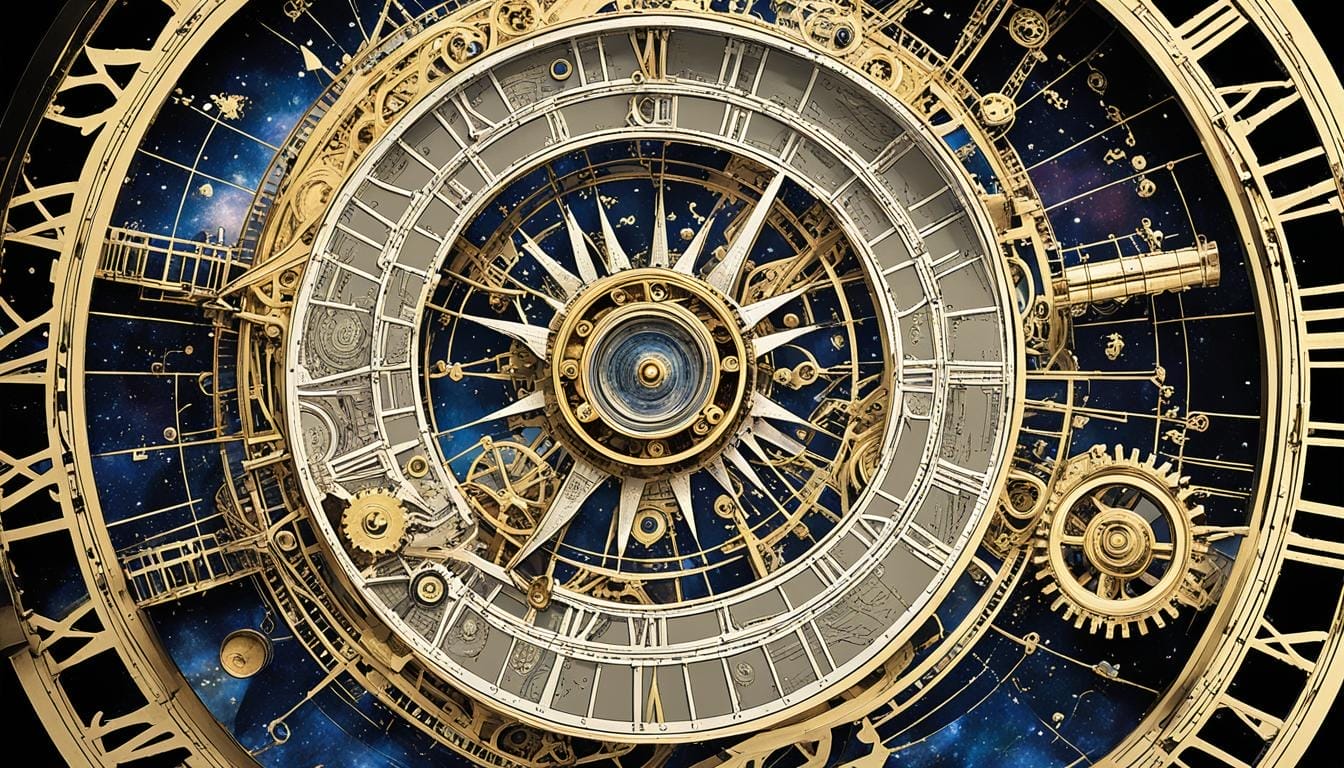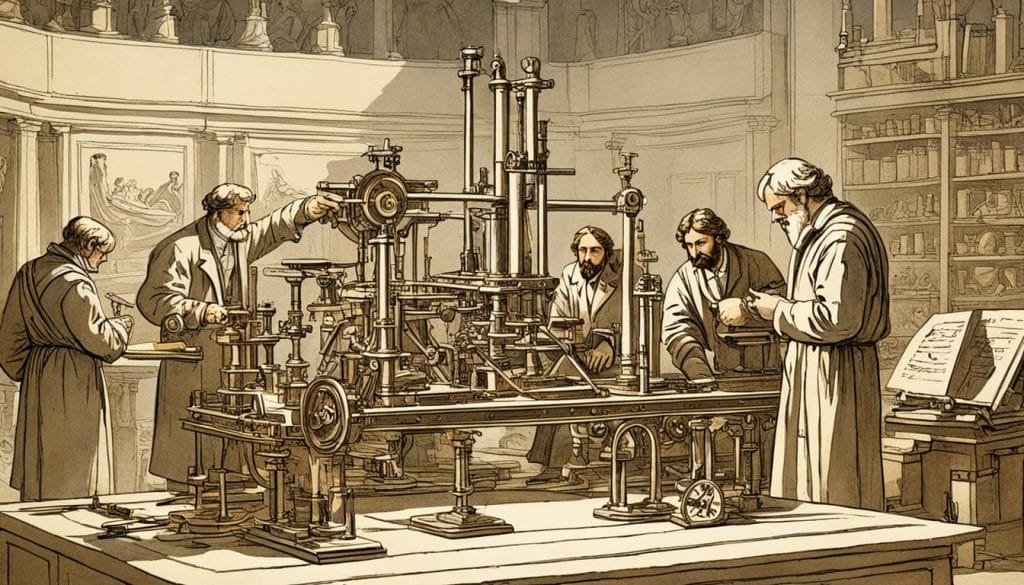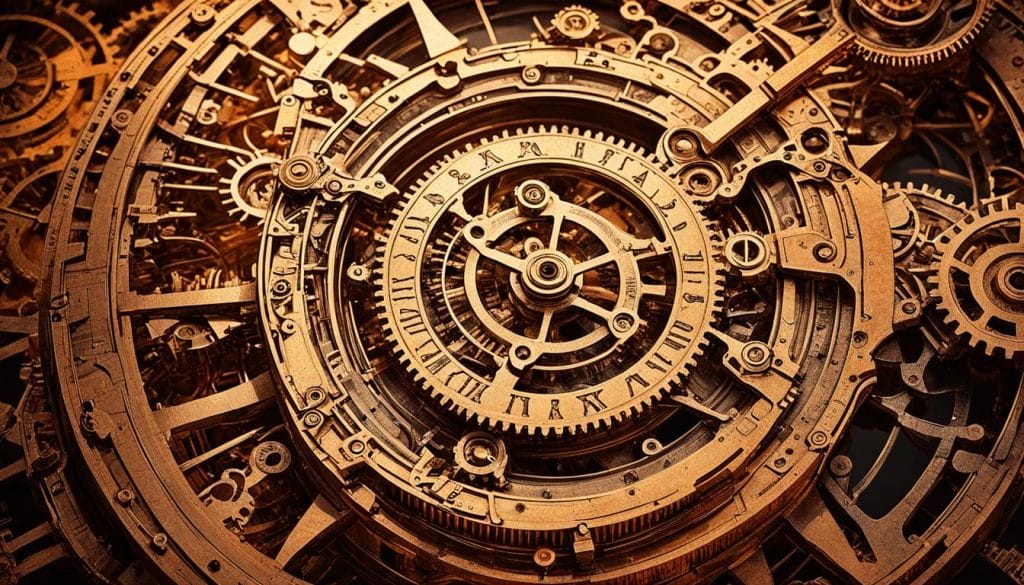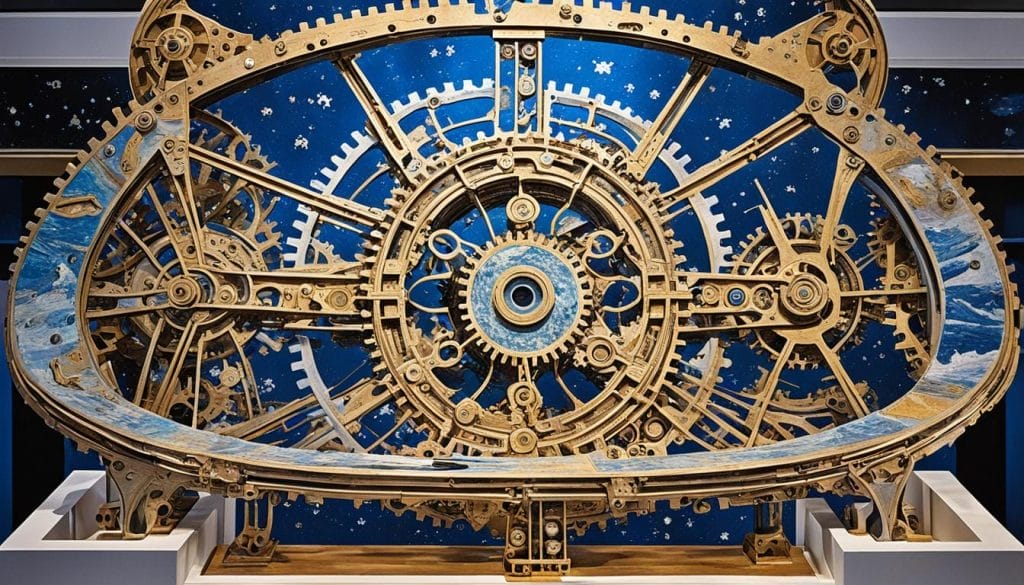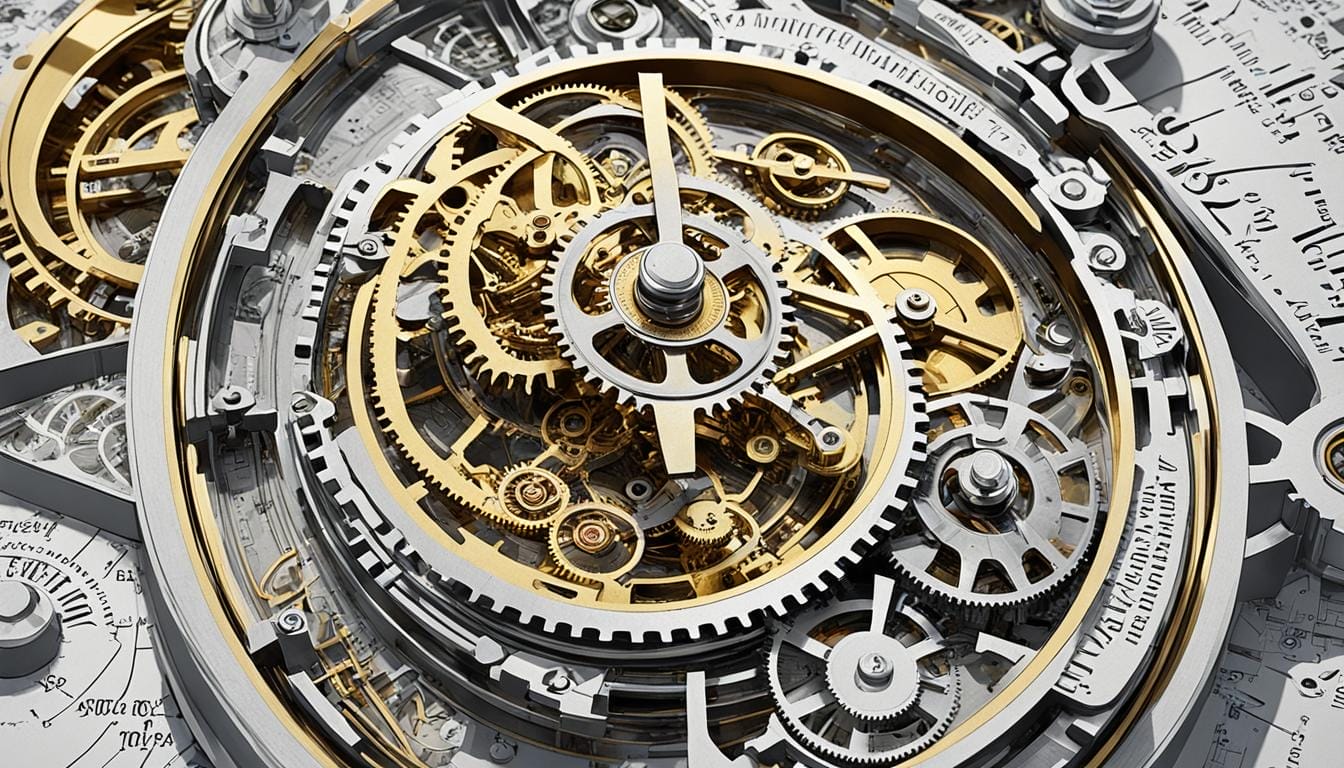Amid the vast expanse of history’s innovative marvels sits a compelling anomaly, one that seemingly defies the technological continuum of its time. Less than 5% of the ocean floor has been explored, yet it’s within this enigmatic abyss that one of the most astounding historical mysteries was discovered: the Antikythera Mechanism. This ancient Greek artifact, unearthed from the depths near a tiny island, is believed to be the world’s earliest known astronomical calculator. It stands as a testimony not just to ancient astronomy but to the impressive heights of Greek engineering. Over 2,000 years old, this device challenges our understanding of technological capacity in the ancient world and continues to captivate as one of humanity’s true technological wonders.
Let’s embark on a journey back in time, to an era where the whispers of Aristotle and Euclid still echoed through the academies, and witness a creation whose complexity would not be replicated for over a millennium. The Antikythera Mechanism isn’t just an intricate assembly of gears; it’s the embodiment of an civilization’s desire to comprehend the cosmos and their remarkable grasp of the universe long before the dawn of the modern computer. Prepare to unravel the threads of this incredibly prescient historical puzzle, whose full purpose and function remain shrouded in the charming cloak of historical mysteries.
Key Takeaways
- The Antikythera Mechanism’s discovery showcases the unexpected sophistication of ancient Greek engineering.
- As an ancient astronomical calculator, it continues to reveal insights into Hellenistic ancient astronomy.
- This artifact exemplifies the transformation of technological wonders into historical mysteries over the millennia.
- The ingenuity behind the device’s construction calls for a reevaluation of our understanding of ancient technologies.
- The Mechanism’s precise functionalities still ignite the curiosity and debate among scholars in the modern era.
The Discovery of the Antikythera Mechanism
In 1900, an extraordinary chapter began in the annals of underwater archaeology when sponge divers came face to face with history submerged beneath the waves. The Greek treasure they encountered within the Antikythera shipwreck has since emerged as a cornerstone of ancient artifacts, offering an unparalleled glimpse into a long-lost era.
The Fateful Storm and the Sunken Treasures
It was a tempest that steered sponge divers towards the discovery of a lifetime near the isle of Antikythera. Taking refuge from the storm’s might, they unwittingly stumbled upon an ancient shipwreck, its contents strewn across the ocean floor. What was entombed in those silent depths would eventually astound the world.
A Mysterious Lump Among Marvels
Among the splendor of marble sculptures and other vestiges of antiquity, lay a seemingly insignificant, corroded lump of metal. This unassuming object, extracted from the sea’s grip and destined for the National Archaeological Museum in Athens, would soon gain recognition far beyond its initial appraisal.
Revelation of the Gears: A Historical Breakthrough
In the confines of the museum, the lump cracked open, not merely in a physical sense, but as a doorway to the past, revealing a complex assembly of bronze gears. These intricately woven remnants of machinery began to challenge the historical perception of ancient Greek technology. Marking the dawn of a new era in underwater archaeology, this ancient shipwreck discovery reshaped the narrative of our ancestors’ scientific achievements—a narrative that continues to be written with each subsequent dive into the murky depths where history once sank.
Peering Into the Ancient Greeks’ Astronomical Knowledge
Among the great intellectual achievements of the ancient Greeks, their understanding of the heavens holds a special place. Their methodologies in observing the celestial sphere emboldened a geocentric perspective, a view that became foundational in the field of astronomy and influenced subsequent generations of scholars and philosophers.
The Geocentric View of the Cosmos
According to the geocentric perspective, Earth stood immobile at the center of the universe, with the fixed stars and planetary bodies revolving around it. This model was elegantly simple and powerfully descriptive, explaining the motion of stars and planets as perceived by ancient naked-eye astronomy. The fixed stars offered a steady backdrop, creating a comparative canvas for the wandering planets.
Unraveling the Motion of Planets and Stars
The motions of the wanderers—what we now call planets—were not random but followed predictable paths characterized by synodic cycles and planetary orbits. The Antikythera Mechanism, a mechanical testament to this astronomical prowess, was devised to track these movements with uncanny precision.
| Astronomical Features | Synodic Cycle (days) | Geocentric Observation |
|---|---|---|
| Venus | 584 | Retrograde Loop |
| Mars | 780 | Apparent Reversal |
| Jupiter | 399 | Slow Prograde Motion |
| Saturn | 378 | Small Retrograde Arc |
By marrying the astronomical insights grounded on the geocentric view with mechanical ingenuity, the ancient Greeks were adept at not only observing the stars but also at predicting celestial events with considerable accuracy. The Antikythera Mechanism stands as a testament to their deep understanding of synodic cycles and planetary orbits, artfully captured in gear and bronze.
The Complex Engineering Behind the Antikythera Mechanism
The Antikythera mechanism, a masterpiece of antiquity, fascinates not only historians but also engineers and scientists. With its interlocking gears and sophisticated design, it serves as a testament to the advanced understanding of astronomical predictions by ancient civilizations. The gears of this ancient computational device, intricately assembled, reveal the Greeks’ extraordinary ingenuity and their ability to turn empirical observation into complex mathematical models.
Decoding Gear Functions and Predictive Power
The genius of the Antikythera mechanism lies in its complex gear train, crafted to model the heavens. Researchers like Derek J. de Solla Price and Charalambos Karakalos have made significant strides in understanding its inner workings through diligent X-ray analysis. Their discoveries indicate that the device could accurately forecast the movements of celestial bodies, suggesting a sophistication far beyond simple timekeeping.
From Simple Observations to Complex Calculations
Building upon basic observational data, the Antikythera Mechanism’s creators engineered a device capable of computing complex astronomical cycles. The presence of at least 30 gears, and possibly more that have yet to be discovered, provided the Antikythera Mechanism with a level of accuracy in making astronomical predictions that is breathtaking even in today’s terms. These findings underscore the remarkable transition from mere stargazing to constructing a device capable of simulating the cosmos.
The ambition behind the Antikythera mechanism demonstrates a bold leap in ancient Greek science and technology. Its influence on both past and contemporary views of historical technological capability cannot be overstated. We may yet find that the true extent of its complexity and sophistication remains to be fully unraveled.
Linking the Antikythera Mechanism to Hellenistic Period Scientists
The intellectual roots of the Antikythera Mechanism, a device that embodies the apex of ancient Greek astronomy, are deeply entwined with the groundbreaking contributions of Hellenistic period luminaries. It’s remarkable to conceive how the sophisticated knowledge of a bygone era was harnessed to develop such an intricate instrument.
Archimedes, known for his profound influence on mechanics and mathematics, is often credited with laying down the theoretical foundations that could have led to the Mechanism’s construction. Though no direct evidence ties Archimedes to the device, the complexity and ingenuity of the gears reflect a level of sophistication consistent with his known works.
Meanwhile, Hipparchus of Rhodes, acclaimed as the father of ancient Greek astronomy, might have provided the essential astronomical insights required for the Mechanism’s accurate representations of the lunar and solar cycles. His theories regarding the irregularity of the moon’s orbit are particularly significant, as they appear to be echoed in the mechanism’s advanced gear designs.
These associations highlight the continuity of knowledge and shared expertise among ancient Greek scientists throughout the Hellenistic period, reminding us that their quests for understanding the cosmos still inspire technological marvels today.
In homage to the historical achievements of these scholars, the following table juxtaposes the contributions of Archimedes and Hipparchus, highlighting their potential impact on the Antikythera Mechanism:
| Scientist | Contributions | Relation to the Antikythera Mechanism |
|---|---|---|
| Archimedes | Inventions in mechanics and mathematics, such as the screw pump and the concept of buoyancy | Inspired mechanical innovations and complex gearing techniques likely utilized in the Mechanism |
| Hipparchus of Rhodes | Detailed models of lunar and solar motion, discovery of the precession of the equinoxes | Provided astronomical calculations that may have informed the Mechanism’s tracking of celestial bodies |
The legacy of these ancient savants is not just archived in the dusty scrolls of history but is vivaciously alive within the corroded cogs and ancient gears of the Antikythera Mechanism, a treasure trove of insight into the astronomical prowess of the Hellenistic period.
Inscriptions and Imagery: A Guide to the Past
The inscriptions on the Antikythera Mechanism have proven to be a Rosetta Stone for unlocking the astronomical knowledge of ancient Greece. These etchings reveal not only the technical function of the device but also gesture towards the profound philosophical and scientific understandings of the period. By deciphering ancient notations, modern scholars are able to step back in time and witness the meticulous Greek astronomical calculations etched into history.
Understanding Ancient Greek Notations
Antikythera Mechanism inscriptions represent a dialogue between past and present, as they inform today’s historians about the Greeks’ representation of time and space. Researchers have painstakingly translated these inscriptions, analyzing their shorthand for referencing celestial cycles and pivotal astronomical events. This effort has revealed the Greeks’ methodical approach to measuring time, a precursor to our modern-day calendar systems.
Interpreting Celestial Cycle Markings
A key aspect of understanding the Mechanism lies in interpreting its inscribed celestial cycle markings. Through rigorous analyses, experts have been able to map out how these markings correlate to solar and lunar cycles. This comprehensive understanding showcases the ancient Greeks’ ability to forecast celestial happenings—predicting lunar and solar eclipses with astonishing accuracy.
| Cycle Name | Duration | Purpose on the Antikythera Mechanism |
|---|---|---|
| Metonic Cycle | 19 years | Used to predict solar and lunar eclipses |
| Saros Cycle | 18 years, 11 days | Enabled accurate lunar and solar eclipse prediction |
| Exeligmos Cycle | 54 years, 33 days | Extension of the Saros Cycle for long-term eclipse forecasting |
| Callippic Cycle | 76 years | Refined the Metonic Cycle for improved accuracy of celestial events |
The Role of the Antikythera Mechanism in Society
The Antikythera device, far from being a mere relic of the past, reflects a profound connection between ancient Greek society and the stars. Astronomy, deeply entrenched in their culture, was not only an academic pursuit but also a functional part of their daily and ritual lives. This mechanism, a masterpiece of engineering, perhaps served a dual purpose—as a scientific instrument and a marker of events crucial to societal rhythms, such as the Olympic Games cycle.
A Tool for Observing Ancient Olympics?
Imagine the bustling energy of ancient Olympia, where every four years athletes, spectators, and dignitaries gathered to celebrate the Olympics. The mechanism may have played a key role in signaling these games. By tracking the Olympic Games cycle, it helped maintain the cultural and religious calendar, informing citizens of the impending festivities dedicated to Zeus—an event intertwined with sportsmanship, honor, and piety.
Cultural Significance of Celestial Predictions
Eclipses and celestial phenomena were often interpreted as messages from the gods, and the Antikythera device held the power to anticipate these events. This predictive ability underscored the cultural importance of astronomy, as it both satisfied a quest for knowledge and provided a comforting semblance of order and predictability amid the mysteries of the cosmos. By connecting the celestial with the terrestrial, the mechanism served as a bridge between the heavens and the earthbound concerns of Greek society.
| Event | Cultural Significance | Role of Antikythera Mechanism |
|---|---|---|
| Olympic Games | Sportsmanship and honor in the name of Zeus | Track cycles of the games |
| Eclipses | Perceived as divine messages | Predict astronomical events |
| Agricultural Seasons | Timing of planting and harvesting | Align agricultural activities with celestial patterns |
In conclusion, the legacy of the Antikythera mechanism carries with it more than the stunning intricacy of its gears—it encapsulates the essence of a people who sought to understand their universe and embody its order in their civilization’s milestones. It was their guide through the cycles of time and their conduit to the divine, proving indispensable for both their survival and spirit.
The Intricate Orrey: A Reconstruction of the Cosmic Dance
The quest to unravel the complex beauty of the Antikythera mechanism has ushered in a new era of exploration into ancient Greek expertise in astronomy and mechanics. At the heart of this renaissance is the Antikythera mechanism reconstruction, an ambitious project that seeks to bridge the chasm between historical theory and tangible reality. To achieve an astronomical visualization that the ancients would recognize, modern-day scholars and craftsmen are combining their forces, intent on piecing together a puzzle laid out by geniuses millennia ago.
Here, the ancient Greek orrey does not merely function as an artifact; it is reborn as the emblem of the grandeur of past civilizations. By painstakingly recreating the device’s gears, contemporary artisans face the intricate challenge of gearwheel fabrication without the conveniences of modern technology. This delicate weaving of history with contemporary skill is aimed at producing an artifact accurate in mechanics and spirit—a three-dimensional narrative of the ancient cosmos.
Visualizing the Heavens with Gearwheels
The Antikythera mechanism, a blend of anthropological treasure and scientific mystique, serves as a testament to the ingenuity of ancient Greek minds. It is the embodiment of technology as an art form—each gearwheel a stanza in an ode to the cosmos. The mechanism’s ability to simulate the harmonious chaos of celestial bodies relies heavily on the craftsmanship and interpretation of existing fragments and historical texts.
The Challenge of Rebuilding Lost History
Restoring the historical visage of the Antikythera mechanism is akin to piecing together an intricate jigsaw puzzle, without the aid of the completed picture. At the University College London (UCL), experts pore over ancient manuscripts and employ cutting-edge imaging techniques to hypothesize the configuration of the lost parts. Their intervention is a chronicle of science, an attempt to reconcile the gaps within which a third of history resides.
The following table highlights the integral components identified and replicated in the reconstruction of the Antikythera mechanism:
| Component | Description | Function |
|---|---|---|
| Main Gearwheel | Central cog of the mechanism | Drives the overall system, simulating solar cycles |
| Ecliptic Ring | Marked with Zodiac signs | Displays the moon’s position throughout its orbit |
| Meteoric Gear | Small, intricate gear | Calculates the occurrence of lunar and solar eclipses |
| Epicyclic Gears | Gears within gears | Model complex planetary motions, reflecting retrograde movement |
| Saros Dial | Spiral dial with glyphs | Predicts eclipse patterns over an 18-year cycle |
This effort to breathe life into the past is not merely an academic exercise—it fuses narrative, history, and science in a singular pursuit. Whether it is in the ambitions of the researchers at UCL or the growing worldwide interest in this ancient Greek orrey; the reconstruction of the Antikythera mechanism champions the endeavor to comprehend a culture’s grasp of the cosmos and codify their legacy in the gears of history.
Technological Marvels: Comparing Past and Future Innovations
Historical technology is not merely a record of human advancement, but a tapestry that connects the past to the present, with legacies such as the Antikythera Mechanism acting as vital threads in this continuum. Ancient innovations like this not only shape our understanding of historical craftsmanship but also influence current benchmarks in engineering excellence. The juxtaposition of ancient vs. modern engineering offers a distinct lens through which we can appreciate the evolution and complexity of mankind’s mechanical pursuits.
The Antikythera Mechanism legacy resides not just in its mechanistic intricacies, but also in its essence as a progenitor of later astronomical clocks and devices. We embark on an innovation comparison, positioning the Greek artifact alongside the prophetic precision of medieval horological inventions.
| Device | Inventor/Origin | Era | Purpose | Technological Complexity |
|---|---|---|---|---|
| Antikythera Mechanism | Unknown, Ancient Greece | 2nd or 1st Century BC | Astronomical Prediction | Over 30 Interlocking Gearwheels |
| Richard of Wallingford’s Clock | Richard of Wallingford | 14th Century AD | Timekeeping, Astronomical Phenomena | Complex Geared Astrolabe |
The parallels drawn between the mechanisms of yesteryear and those of subsequent epochs echo a sentiment of awe and inquiry. The existence of an object as advanced as the Antikythera Mechanism bears the question of why such eminent expertise appeared to pause before resurfacing in later centuries.
The
“standing on the shoulders of giants”
analogy may be apt in the realm of scientific thought, yet the physical evidence of a technological lineage from the Antikythera Mechanism to other comparable artifacts seems to be shrouded in the mists of time. What can be said with certainty is that each step forward in the annals of our engineering ventures is a testament to the unyielding power and potential of human innovation.
Conclusions: Reflecting on the Ingenuity of the Antikythera Mechanism
The Antikythera Mechanism’s enigma simmers in the cauldron of ancient Greek achievements, a testament to a civilization’s peak in astronomical and engineering prowess. Its complexity whispers tales of our ancestors’ advanced understanding, marking it as an enduring symbol of the Antikythera Mechanism legacy. Yet, despite its mechanical marvel and rich contribution to our perception of ancient technological advancements, this relic harbors as much mystery as admiration from our modern gaze, leaving us to ponder over the historical enigmas it presents.
Unanswered Questions and Legacy
Contemplating the Mechanism’s purpose and the creators’ intentions unravels a multitude of theories, but concrete answers remain elusive. Acknowledged as an artifact par excellence, it exemplifies the preservation of knowledge and simultaneously its vulnerability. The savage tides of time have engulfed similar inventions in obscurity, leaving us to speculate on the Mechanism’s singular place in history and what secrets of ancient ingenuity are still buried, waiting for rediscovery.
Why Did Such Technology Vanish?
The peculiar absence of comparable instruments in the archaeological record prompts a profound inquiry—how did such intelligence seemingly dissipate into the folds of antiquity? It teases the potential of historical gaps in our archives and challenges the narrative of linear progression in technology. This dialogue touches upon the fragility of cultural memory and the resilience needed to ensure the continuity of humanity’s intellectual achievements. Obscured by the dust of eons, the Antikythera Mechanism’s story is far from over, delivering new chapters as persistent scholars unearth and decipher its mechanics and meanings.
FAQ
What is the Antikythera Mechanism?
The Antikythera Mechanism is an ancient Greek artifact that is considered to be the earliest known analog computer. It was used to predict astronomical positions and eclipses with remarkable precision. Crafted over 2,000 years ago, it highlights the advanced astronomical and mathematical knowledge of the Hellenistic period.
How was the Antikythera Mechanism discovered?
It was discovered by sponge divers, notably Elias Stadiatis, in 1901 near the Greek island of Antikythera. Initially found within a shipwreck, it appeared as a corroded bronze lump that was later revealed to be a complex device with over 30 gearwheels after examination at the National Archaeological Museum in Athens.
What did the ancient Greeks understand about astronomy?
Ancient Greeks had significant skills in naked-eye astronomy and operated from a geocentric perspective, understanding the fixed stars and the erratic motions of ‘wandering’ planets. They were aware of astronomical cycles such as prograde, retrograde, and synodic motions, and incorporated this knowledge into the Antikythera Mechanism.
How complex is the engineering of the Antikythera Mechanism?
The Antikythera Mechanism was a marvel of engineering that included at least 30 interlocking gears. Its complexity allowed it to track celestial movements with a level of accuracy that was unheard of for its time, serving as a sophisticated computational and observational tool.
Who may have influenced the design of the Antikythera Mechanism?
The design and functionality of the Antikythera Mechanism may have been influenced by notable Hellenistic scientists such as Archimedes and Hipparchus of Rhodes, who had contributed significantly to ancient scientific theories in astronomy and mathematics of that era.
What role did the inscriptions on the Antikythera Mechanism play?
The inscriptions on the Antikythera Mechanism likely acted as a user’s manual, describing celestial cycle markings and notations that provided contemporary experts with clues to its purpose and operation. These inscriptions have been crucial in reconstructing and understanding the device’s astronomical calculations.
What societal role did the Antikythera Mechanism have in ancient Greece?
Beyond its technological significance, the Antikythera Mechanism may have had practical uses in Greek society, such as marking the cycle of the ancient Olympic Games. It was also culturally important for predicting eclipses, which were often interpreted as omens or divine messages.
What challenges are involved in reconstructing the Antikythera Mechanism?
Reconstructing the Antikythera Mechanism entails visualizing the heavens as understood by the ancient Greeks and crafting a functional model. Challenges include deciphering missing parts of the mechanism and accurately fabricating gearwheels using only ancient techniques without modern equipment.
How does the Antikythera Mechanism compare to later technological innovations?
The Antikythera Mechanism predates later technological inventions, such as 14th-century astronomical clocks, by over a millennium. Its sophisticated design has puzzled historians as there seems to be a significant gap in the mechanical complexity and advancement of similar technologies until much later in history.
Why is the Antikythera Mechanism’s technology considered to have vanished?
The reason for the disappearance of technology similar to the Antikythera Mechanism remains a mystery. The lack of comparable devices from the period suggests a potential loss of knowledge or indicates that other advanced instruments from antiquity may still await discovery.
Source Links
- https://www.scientificamerican.com/article/an-ancient-greek-astronomical-calculation-machine-reveals-new-secrets/
- https://en.wikipedia.org/wiki/Antikythera_mechanism
- https://www.theguardian.com/science/2021/mar/12/scientists-move-closer-to-solving-mystery-of-antikythera-mechanism

